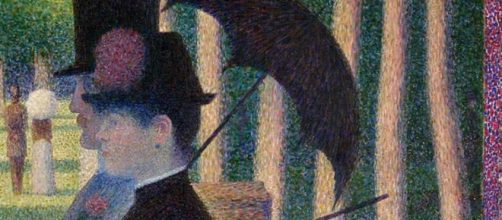What’s the most cheerless painting of modern life you can think of? Skip the obvious ones like Edward Hopper’s "Nighthawks" with those solitary diners avoiding even a glance at one another (conceivably accounting for the U.S. suicide rate reportedly rising for decades).
Sadness in the sun
There’s no right answer, of course. For me, the last word in latter-day doldrums imagined in paint is George Seurat’s deceptively sunny "Sunday Afternoon on the Island of La Grande Jatte."
I saw my choice unexpectedly shored up last week when Katie White, editor at Artnet News, wondered in print if “Sunday Afternoon” is the “most misunderstood painting of the modern era.”
Granted, a casual glance gives the impression of a walk in the park – working-class Parisians out with their families taking their day off by the river Seine.
But on close inspection, a forlornness comes into focus. White scrupulously describes the figures as “frozen in time, isolated from one another, their distinguishing facial features obscured – mere mannequins of life.”
But here’s the thing. Nothing of what White describes was Seurat’s intention, at least made known in his voluminous correspondence. His letters of intent not only disregard views like hers (and mine), but they also make clear how irrelevant they are to what he was trying to do.
Writing to an unnamed artist friend, art historians Robert Treves and Marco Treves quotes Seurat saying, “They see poetry in what I have done. No, I apply my method, and that is all there is to it.”
Method to his madness
OK, George, let’s talk about your “method.” Rather than brushstrokes, you use small, equal-sized dots of color that tend to nail your figures to the spot.
And for increased stability, you repeated shapes, such as the curves of a parasol, a dog’s tail, and a woman’s hat. You called your method “pointillism.”
Impressionism was all the rage in your time, and you didn’t like the spontaneous look or the formlessness. You wanted something more exacting and premeditated. I get that. But there’s premeditation, and there’s obsessiveness, George. You painted thirty-eight studies and twenty-three preparatory drawings for “Sunday Afternoon.”
And, though you disparaged Impressionism, you borrowed something from the style: the intense unmixed color side by side, creating a shimmering effect. From all appearances in your letters, you go on and on about your “method” without a nod to your debt to Impressionism.
In a letter to your biographer Jules Christophe, you write, “The means of expression is the optical mixture of tones and colors according to the laws of contrast, sequence, and irradiation...”
But here’s why I don’t believe you, George, when you write, “I apply my method, and that is all there is to it.” Your figures don’t interact or touch or talk to one another. You could have used the same dot method and pictured people interacting, but you didn’t. You chose to show them alienated.
Art isn’t about technique, George. Without a story or a state of mind, a slant of some kind, all you get is optics. Your equal-size dots, made with machinelike precision, described the joyless, bored faces of the maids and clerks in 19th-century Paris. You should have owned that.


